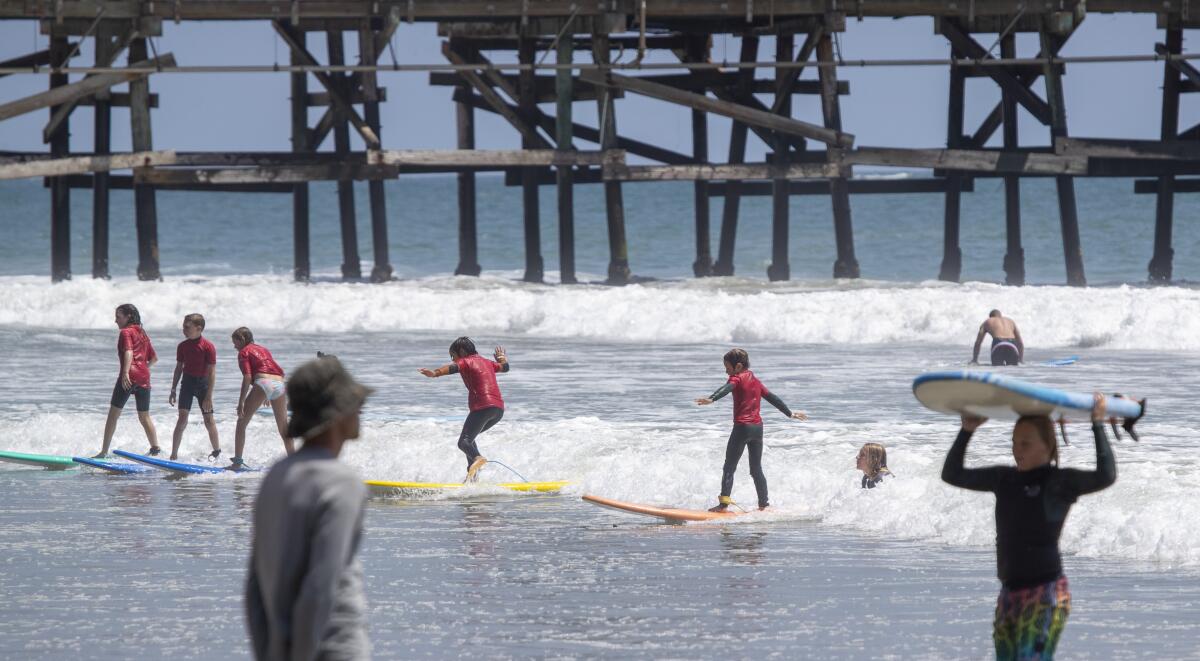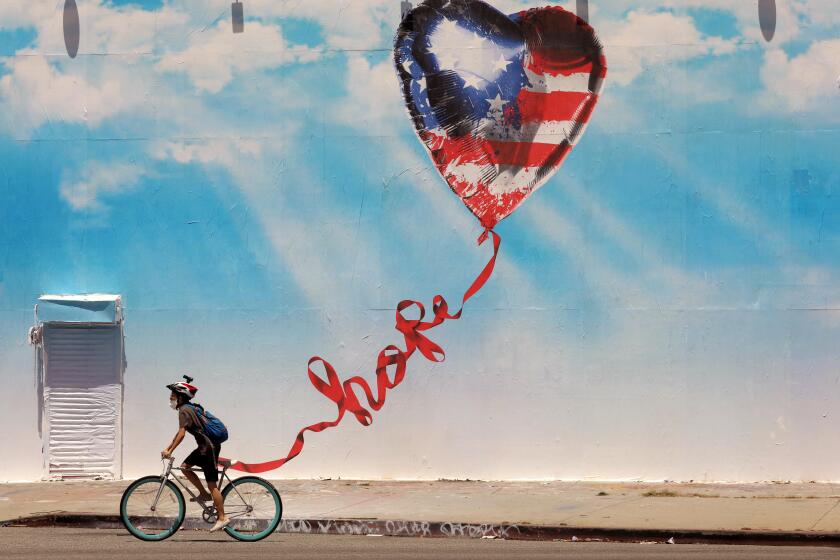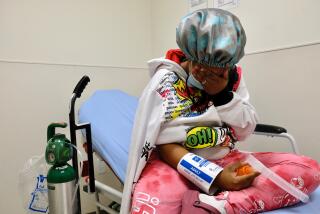California fears July 4 coronavirus disaster, plans new restrictions

State and local governments planned more restrictions Tuesday as coronavirus cases continued to spike and officials became increasingly alarmed that the July 4th holiday weekend could bring a wave of new infections that could overwhelm hospitals.
The surge in coronavirus cases and hospitalizations began around the Memorial Day weekend as residents began socializing after months largely spent at home, and officials say a repeat of that behavior — failing to wear masks and mixing with many people outside of your household — this holiday weekend would be disastrous.
“I think it is a critical moment for the public health message to be given out and heard,” said Dr. Robert Kim-Farley, medical epidemiologist and infectious diseases expert at the UCLA Fielding School of Public Health. “Traditionally, the Fourth of July has been such a time for large gatherings and beach going. If those same practices occurred, we could be back with even a further spike upon our spike that we’re having now.”
Past holidays where there was extensive social interaction, like Mardi Gras in Louisiana and the Lunar New Year holiday in Wuhan, China, have been associated with big spikes in COVID-19 that reverberated across their respective nations.
Gov. Gavin Newsom on Wednesday ordered tougher restrictions on indoor activities for most of the state, marking a major step backward in the reopening and an attempt to slow an alarming rise of the coronavirus in 19 counties.
For the second consecutive day, California broke a record for the most cases reported in a single day — 8,610 cases, according to The Times’ coronavirus tracker. It was only the second time the state has recorded more than 8,000 cases in a single day.
Dr. Anthony Fauci, the director of the National Institute of Allergy and Infectious Diseases, warned Tuesday that new cases nationally could rise to 100,000 a day if behaviors don’t change.
The nation is currently recording about 40,000 cases a day. That’s double what the country saw the first week of June, when there were an average of 20,700 cases reported daily.
The percent of coronavirus tests coming back positive in California continued to rise — hitting 5.95% Tuesday, a Los Angeles Times analysis found, up from 5.28% a week earlier, and 4.45% a week before that. That’s an indication that disease spread is worsening.
The Times’ analysis has found that the average number of patients hospitalized in California with confirmed or suspected COVID-19 rose 36% last week compared to what it was a month earlier.
On Tuesday, Ventura County joined Los Angeles County in closing beaches during the holiday, while San Diego County imposed a 10 p.m. curfew on all restaurants and bars in a move to close down alcohol-fueled nightlife that some fear is helping spread COVID-19.
“We simply cannot go on with business as usual while this virus continues to rage our nation and our community,” said San Diego County supervisor Greg Cox.
Gov. Gavin Newsom said he planned to announce additional restrictions Wednesday.
“We’ll be making some additional announcements on efforts to use that dimmer switch that we’ve referred to and begin to toggle back on our stay-at-home order and tighten things up,” Newsom said. “The framework for us is this: If you’re not going to stay home, and you’re not going to wear masks in public, we have to enforce, and we will.”
The governor warned that changes would also include restrictions on indoor gatherings but did not provide details. Newsom said family gatherings had been one of the “areas of biggest concern” as immediate and extended family members mixed together.
Some people frightened by the spike in cases said they would welcome stricter rules.
“To save people that are dying or getting infected, why open it up when it’s not ready or safe to do so?” said Teshome Tekeste, 23, as he walked in Santa Monica on Tuesday.
He said he’s being cautious: only eating takeout, masking-up when friends are around. The coming holiday scares him.
“I’m worried and nervous. I know we were doing really good prior to opening bars and restaurants and stores, and once we opened a gateway, that really opened up everything else,” Tekeste said. “With July 4th coming up this weekend, I feel like a lot of people are going to be out regardless of the restrictions.”
As beaches and bars close, he’s not sure what he’ll do on Saturday. “It’s hard to tell. When the day comes, I’ll probably figure something out,” Tekeste said. “I’ll feel comfortable doing anything if I know I will be protected — myself and the people around me. But I can’t control other people’s actions, so that’s the issue that I don’t know.”
As she walked to the Apple store in Santa Monica, Terry Marie said she almost canceled her appointment upon seeing Monday’s spike in COVID-19 cases.
The virus had already scrapped her Fourth of July plans, she said.
“I’ll probably be upstairs on my porch looking out, seeing if I see any fireworks,” said Marie, a Venice resident in her 50s.
Marie called off a watch party set for Friday night for the digital release of “Hamilton” after a friend told her local and state orders prohibit household mixing.
“I’ve got to be honest, it’s getting old now,” she said.
Officials have said there are several likely causes for the spike — people hanging out in crowded spaces without masks as well as the return of private gatherings like family barbecues, graduation parties and Father’s Day events. The protests over the police killing of George Floyd, which brought tens of thousands onto streets, might also have spread coronavirus but there is debate about how much.
In the Inland Empire, hospitals are hovering at capacity levels, and officials in Los Angeles and elsewhere said they are just weeks from that point unless the spread can be slowed. That is why so much focus is being placed on keeping July 4 weekend under control.
“I know how much we look forward to this time of year,” Los Angeles Mayor Eric Garcetti said Monday evening. “But not this year. This year we have to think about saving lives to protect what we have in this country.”
The state is monitoring 19 counties that have fallen short of meeting guidelines for at least three days due to an increase in the spread of the virus, growing hospitalizations or a lack of hospital capacity. Newsom said he expected four additional counties to be added to the list on Wednesday.
California has 232,273 confirmed cases and more than 6,000 deaths from COVID-19, according to the Los Angeles Times tracker of the outbreak. California was long hailed as a coronavirus success story.
“We bent the curve in the state of California once. We will bend the curve again, mark my word,” Newsom said. “We will crush this pandemic. We will annihilate it. We’ll get past this, but we’re going to have to be tougher. And we’re going to have to be smarter in terms of our approaches.”
Increasing numbers of California counties are following Newsom’s guidance and closing bars.
“People don’t social distance well after a couple drinks, and it’s one of the hardest environments to trace contacts in,” Riverside County Public Health Officer Cameron Kaiser said Tuesday.
But some spots remain resistant.
Michelle Steel, chairwoman of the Orange County Board of Supervisors, said Tuesday that the health officer “is considering the issuance of health orders to close bars in Orange County if, in his medical opinion, it is appropriate to do so.”
“Throughout our pandemic response, and in our phased reopening, we have consistently stated that we would closely monitor the data and correct course as needed,” she said. “I, and my colleagues on the Orange County Board of Supervisors, remain dedicated to protecting the health and safety of our residents.”
Times staff writers Colleen Shalby, Luke Money, Iris Lee, Andy Roberson and Paul Sisson of the San Diego Union-Tribune contributed to this report.
More to Read
Sign up for Essential California
The most important California stories and recommendations in your inbox every morning.
You may occasionally receive promotional content from the Los Angeles Times.














